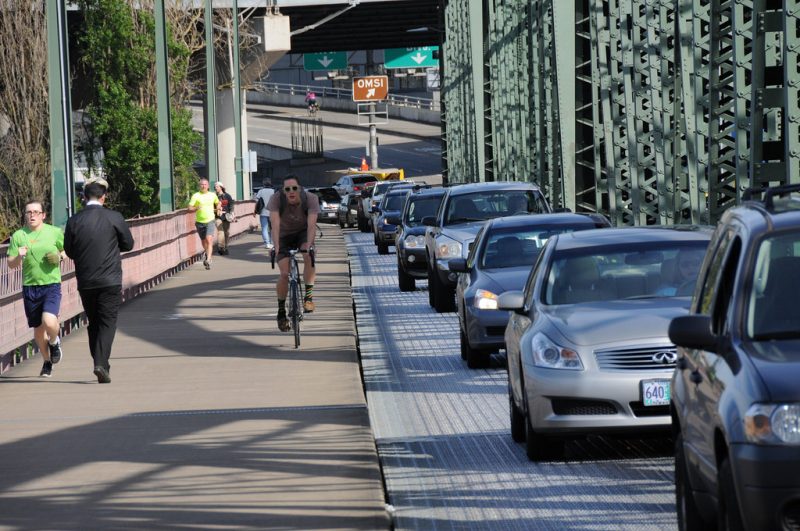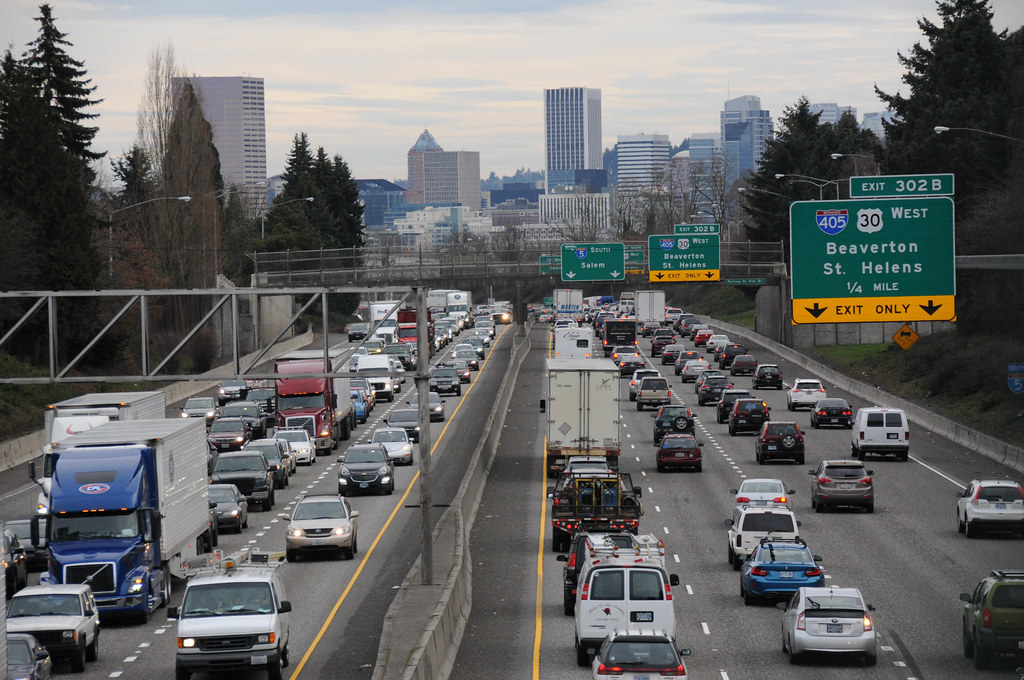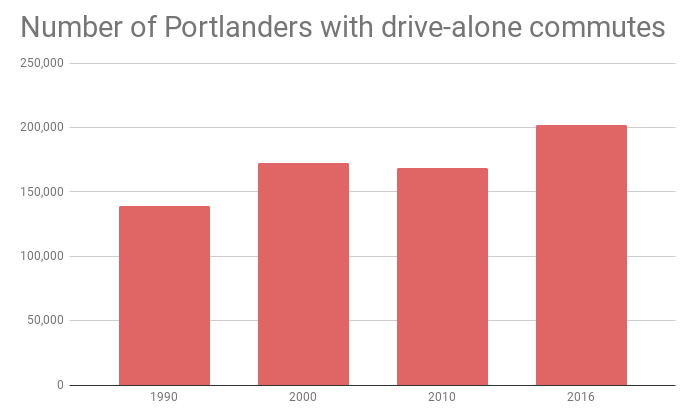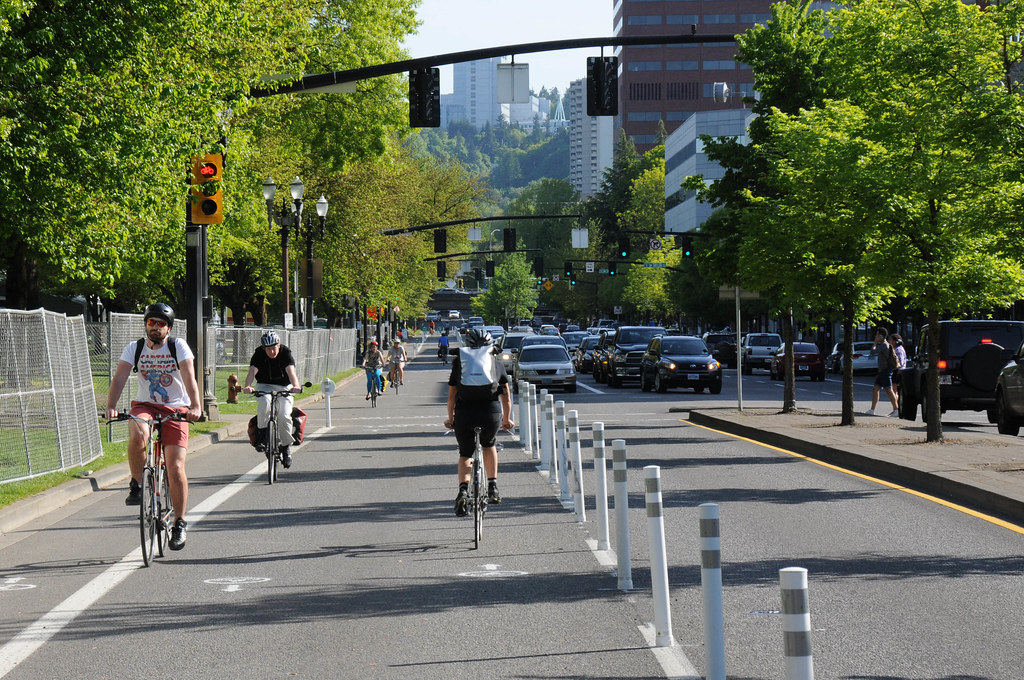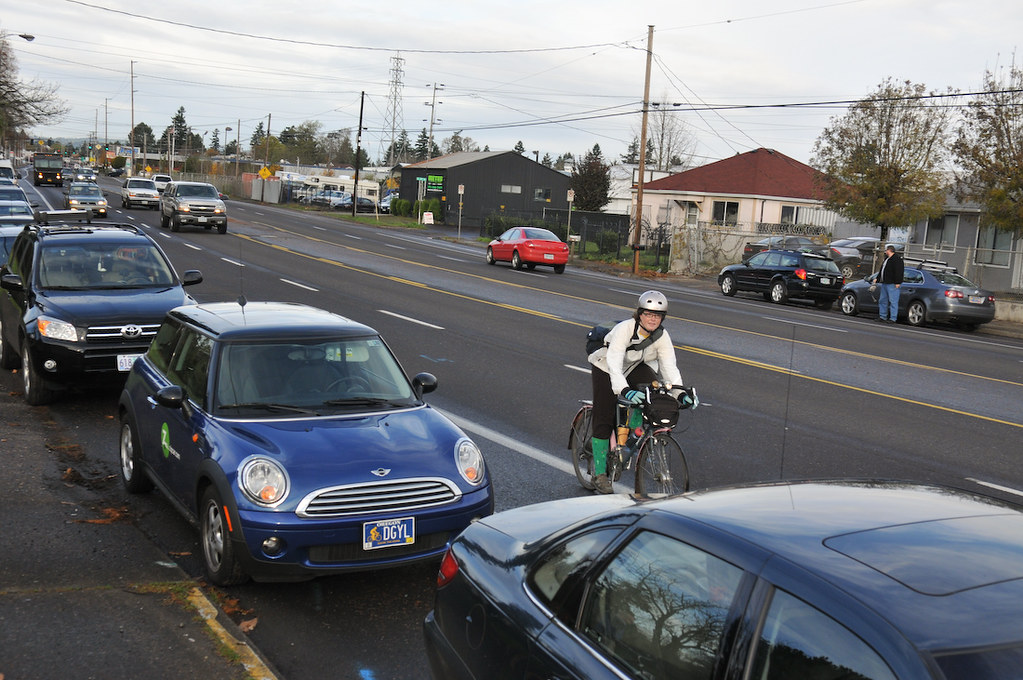It’s not your imagination: auto traffic got worse in Portland last year.
One of the main reasons: it looks like almost none of the additional commutes that originated in Portland in 2016 happened on bikes, foot or public transit. Instead, of the 12,000 additional commutes Portland added in 2016, 11,000 happened in cars.
That’s according to the latest commuting estimates from the Census Bureau, at least. The citywide bike commuting rate slipped from an estimated 7 percent of commuters to 6.3 percent, the same biking rate estimated in 2011.
Portland’s latest bike-commuting ebb — or, depending on the amount of error in the survey, Portland’s continuing bike-commuting plateau — corresponds to a similar softening of national bike-commute growth that seems to have begun at about the same time global oil prices plummeted: Thanksgiving weekend in 2014. On average, gasoline cost $2.25 per gallon in the U.S. in 2016, down 35 percent from 2014.
This time last year, we noted that the drop in gas prices didn’t seem to be affecting commute patterns yet. That may have changed.
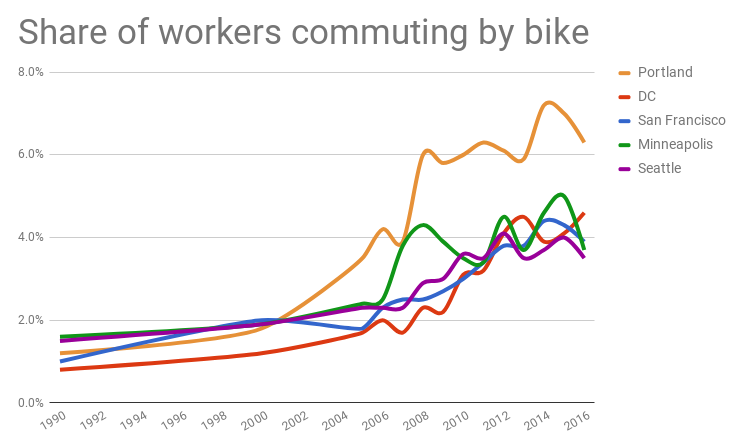
Minneapolis and Seattle also saw downticks in this year’s annual bike-commuting estimates, though (like Portland) their longer-term trends continue to point gently upward. Washington DC reversed a 2015 drop. Estimates for cities like New Orleans, Tucson, Philadelphia, Chicago, New York and Los Angeles all stayed more or less where they have been.
Even Davis, Calif., for decades the U.S. city with the most bike transportation, saw its estimate decline for the third consecutive year. An estimated 17 percent of its working residents now get to their jobs by bike, down from 25 percent in 2013.
A few cities with relatively dense urban cores, lower biking rates and recent investments in their bike lane networks did see upticks in 2016: Pittsburgh, Detroit, Cleveland.
When biking, walking and transit are flat, job growth brings congestion
Portland’s continuing lack of transit commuting growth comes as, unfortunately, no surprise. We already knew TriMet ridership per capita has fallen 7.4 percent since 2010. The steepest ridership drops are on the system’s buses, which increasingly find themselves stuck behind long lines of one- and two-occupant cars.
It all adds up to a vicious cycle of auto use.
During the first decade of the 2000s, despite an admittedly much weaker economy, Portlanders added a total of 15,000 new jobs to local payrolls. But because biking commutes and (to a lesser extent) digital, transit and walking commutes all grew substantially during those years, the number of drive-alone commutes actually fell by 4,000 over that decade.
The result, as we wrote in 2015, was a growing city that temporarily enjoyed the luxury of forgetting what it feels like for congestion to get worse.
According to the Census, that’s no longer the case. The number of drive-alone commutes by Portlanders is up about 24,000 from 2010 to 2016. You can blame population or job growth: if neither had changed, the number of car commutes would be basically unchanged, too. But you also have to blame something else: a city that has stopped improving its non-car options fast enough to keep up with population and job growth.
“The bigger investments we make in active transportation, the easier it is to get around using it,” Street Trust spokesman Romain Bonilla said in an interview Wednesday. “Without these investments, naturally people are going to be using single-occupancy motor vehicles. Which overall, in the aggregate, increases congestion.”
There’s some good news in this year’s numbers, too
A possible bright spot: Portland bike commuters are now estimated to be only 61 percent male. That’s down several percentage points from last few years and an all-time low estimate, suggesting that biking may at least be coming closer to being equally useful to male and female Portlanders.
Also, the actual number of bike commuters hasn’t shrunk much, if at all. The Census estimate is down from 23,432 to 21,982, statistically unchanged. The bike-commuting ratio fell mostly because the number of Portlanders with jobs went up. So if you haven’t noticed much change in bike traffic, that’s consistent with these figures.
Advertisement
For more and more families, the war on cars has reached a truce. Two-worker, one-car households hit another high in 2016. An estimated 27 percent of Portland’s two-worker households now live this way, up from 19 percent in 2005. (This isn’t a national trend. In Portland’s suburbs, this figure has gone from 8 percent to 10 percent; nationwide, from 10 percent to 11 percent.)
Even so, the majority of Portland families who rely on cars seem to be buying more of them. After several years in which car ownership hadn’t rebounded from the recession, the total number of vehicles in Multnomah County per resident edged upward in 2016.
The one car-free commuting mode to grow in Portland in 2016 was working at home. About 3,000 more Portlanders worked at home in 2016 than in 2015, the Census estimated, bringing the city’s work-at-home rate to a modern high of 8 percent.
A city with a growing to-do list
Today’s news comes as Portland has an unusually large backlog of major projects planned but unbuilt.
East Portland’s network of neighborhood greenways has seemingly been in limbo since former Mayor Charlie Hales yanked funding for the program in 2013. Foster Road bike lanes were approved in 2013 and have now been delayed for several years running (though the plans have also, happily, been improving). A crucial northwest Portland bike-walk bridge was funded by lottery revenue last year but won’t finish until 2020 at the soonest. A similarly crucial northeast Portland bridge seems to be funded but doesn’t have a target build date. A network of protected bike lanes and paths is supposed to arrive in the Gateway area, just east of Interstate 205 and south of Interstate 84, in the next three years, including outer Halsey and a new underpass beneath 205. Oregon’s legislature just devoted $110 million mostly for crosswalks, sidewalks and bike lane improvements on the state-owned Powell Boulevard, changes that will take years to negotiate and execute. And a network of protected bike lanes in Portland’s central city got $6 million from the regional government in 2013 and another $2.8 million from local voters in 2016. So far, that project’s public output is a single public meeting, last spring, to discuss one area of its scope.
As for public transit, the 2017 legislature also approved a major funding increase, paid for with a hike to payroll taxes. TriMet is currently calculating which bus lines to improve. The agency has two infrastructure projects on the drawing board, an “enhanced” bus line on Division Street and a new MAX line on Southwest Barbur and/or Interstate 5, but they’ve been repeatedly sent back to their drawing boards. Meanwhile, an effort to dedicate more lane space to buses seems to be getting love from both city officials and grassroots advocates.
In all, Portland does not seem short on ideas for big improvements to non-car transportation. What seems to be missing is the will to execute anything but the smallest ideas quickly — and also, said Emily Guise of activist group BikeLoudPDX, the will to put burdens on driving other than more and more congestion.
Thanks to rapid growth of high-risk auto loans, she said in an interview Wednesday, “it’s easier to get a car and get financing than it ever was before. You couple that with low gas costs and we don’t really charge for parking in Portland very much at all. … As much as people complain about the congestion and the traffic, you can still get to most places fairly easily in a fairly decent amount of time. That’s why people continue to commute by themselves.”
Guise, the group’s chair, said she hopes the new Census estimates “will kind of pop that self-congratulatory bubble a little bit.”
Faster shifts away from driving would ultimately be in the whole city’s interest, she said.
“Traffic is terrible. People can’t get to where they need to go in a reasonable time. And that includes a lot of people who ride transit regularly. And there’s just not enough space to have 11,000 — if we keep having more and more tens of thousands of people driving to work every day, congestion and traffic will only get worse, the air quality will only get worse. The cars will continue taking up a lot of space that could be used for other things.”
City transportation spokesman John Brady said Wednesday that the city will comment after the Census figures are publicly released Thursday.
— Michael Andersen: (503) 333-7824, @andersem on Twitter and michael@portlandafoot.org.
Never miss a story. Sign-up for the daily BP Headlines email.
BikePortland needs your support.
